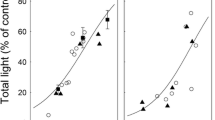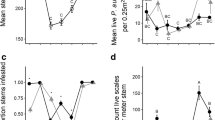Abstract
Salt marshes dominated by Spartina alterniflora and the associated networks of tidal creeks that drain them are characteristic geographical features of southeastern estuaries, important nursery habitat areas, and preferred sites for residential development. As the size of the coastal population increases, so has the number of requests for dock permits. With each new request for a dock permit, public concerns about the cumulative environmental impacts of dock proliferation on the coastal environment have increased. The objective of this particular study was to evaluate the impacts of shading by dock structures on stem densities of S. alterniflora in South Carolina coastal marshes. Shading impacts under individual docks were extrapolated to the tidal creek (local), county, and statewide scales. Dock structures were sampled both under and next to the walkway in the Charleston Harbor area of South Carolina. The density of S. alterniflora under docks was significantly lower than that which occurred next to the docks (i.e., 5 m away) for the short-form, tall-form, and both forms combined. We estimated that shading effects from dock structures in South Carolina decreased the stem density of S. alterniflora by 71%. Dock shading effects were small when evaluated from the perspective of the amount of marsh that occurs within specific tidal creeks (0.03–0.72%), in coastal counties at a maximum dock length (0.01–0.98%), or statewide (0.01–0.13%) at a maximum dock length. However, approximately 7,000 docks have been permitted over the last decade, resulting in a loss of salt marsh equivalent to 60 ha.

Similar content being viewed by others

References
Allen, J., and K. S. Lu. 2000. Modeling and predicting future urban growth in the Charleston area. Strom Thurmond Institute, Clemson University, Clemson, SC.
Cofer-Shabica, S., J. Hackett, F. Phillips, G. Phipps, W. Reynolds, and H. Robinson. 1999. The citizen’s guide to the Charleston Harbor Project. Office of Ocean and Coastal Resource Management, Charleston, South Carolina, 76 pp.
J. E. Cohen C. Small A. Mellinger J. Gallup J. Sachs (1997) ArticleTitleEstimates of coastal populations Science 278 1211–1212 Occurrence Handle1:CAS:528:DyaK2sXntlKmsLs%3D
Colligan, M., and C. Collins. 1995. The effect of open-pile structures on salt marsh vegetation NOAA/NMFS Pre-publication Draft Report. 15 pp.
R. Constanza R. D’Arge R de Groot S. Farber M. Grasso B. Hannon K. Limburg S. Naeem R. O’Naill J. Parueol R. Raskin P. Sutton M van den Belt (1997) ArticleTitleThe value of the world’s ecosystem services and natural capital Nature 387 253–260 Occurrence Handle10.1038/387253a0 Occurrence Handle1:CAS:528:DyaK2sXjtlShtbs%3D
Field, D. W., A. J. Reyer, P. V. Genovese, and B. D. Shearer. 1991. Coastal wetlands of the United States: An accounting of a valuable national resource. NOAA Anniversary Report, US. Fish and Wildlife Service, Washington DC, 59 pp.
C. T. Hackney W. D. Burbanck O. P. Hackney (1976) ArticleTitleBiological and physical dynamics of a Georgia tidal creek Chesapeake Science 17 271–280
Hoffman, W. F. II. 1991. Temporal and spatial distribution of ichthyofauna inhabiting the shallow marsh habitat of the Charleston Harbor Estuary. Master’s Thesis. College of Charleston, Charleston, South Carolina, 137 pp.
Kearney, V. F., Y. Segal, and M. W. Lefor. 1983. The effects of docks on salt marsh vegetation. Connecticut State Department of Environmental Protection, Hartford, Connecticut. 22 pp.
R. T. Kneib (1993) ArticleTitleGrowth and mortality in successive cohorts of fish larvae within an estuarine nursery Marine Ecology Progress Series 94 115–127
S. B. Lerberg A. F. Holland D. M. Sanger (2000) ArticleTitleResponses of tidal creek macrobenthic communities to the effects of watershed development Estuaries 23 838–853 Occurrence Handle1:CAS:528:DC%2BD3MXhsFCku74%3D
McGuire, H. L. 1990. The effects of shading by open-pile structures on the density of Spartina alterniflora. Master’s Thesis, College of William and Mary, Virginia Institute of Marine Science, Gloucester Point, Virginia, 112pp.
C. C. McIvor W. E. Odum (1988) ArticleTitleFood, predation risk, and microhabitat selection in a marsh fish assemblage Ecology 69 1341–1351
M. Miller (1993) ArticleTitleThe rise of coastal and marine tourism Ocean and Coastal Management 21 183–199 Occurrence Handle10.1016/0964-5691(93)90026-U Occurrence Handle1:STN:280:ByyA2M3jt1M%3D
InstitutionalAuthorNameNOAA (2001) ArticleTitlePrivate docks: Fighting for the public’s rights in New York Coastal Services Linking People, Information, and Technology 4 4–6
D. T. Osgood J. C. Zieman (1998) ArticleTitleThe influence of subsurface hydrology on nutrient supply and smooth cordgrass (Spartina alterniflora) production in a developing barrier island marsh Estuaries 21 767–783 Occurrence Handle1:CAS:528:DyaK1MXitlaks70%3D
C. H. Pederson J. Lubchenco (1997) Marine ecosystem services. Pages 177–194 C. G. Daily (Eds) Nature’s services: societal dependence on natural ecosystems Island Press Washington, D.C.
D. M. Sanger A. F. Holland G. I. Scott (1999a) ArticleTitleTidal creek and salt marsh sediments in South Carolina coastal estuaries. I. Distribution of trace metals Archives of Environmental Contamination and Toxicology 37 445–457 Occurrence Handle10.1007/s002449900539 Occurrence Handle1:CAS:528:DyaK1MXntlGrtbo%3D
D. M. Sanger A. F. Holland G. I. Scott (1999b) ArticleTitleTidal creek and salt marsh sediments in South Carolina coastal estuaries. II. Distribution of organic contaminants Archives of Environmental Contamination and Toxicology 37 458–471 Occurrence Handle10.1007/s002449900540 Occurrence Handle1:CAS:528:DyaK1MXntlGrtbs%3D
Sanger, D. M., A. F. Holland, and D. L. Hernandez. In press. Evaluation of the impacts of dock structures and land use on tidal creek ecosystems in South Carolina estuarine environments. Environmental Management.
SCDHEC. 1999. OCRM Regulations: Rules and regulations for permitting in the critical areas of the coastal zone. SCDHEC/OCRM, Charleston, South Carolina, 68 pp.
J. M. Shenker J. M. Dean (1979) ArticleTitleThe utilization of an intertidal salt marsh creek by larval and juvenile fishes: abundance, diversity, and temporal variation Estuaries 2 154–163
J. M. Teal (1962) ArticleTitleEnergy flow in the salt marsh ecosystem of Georgia Ecology 43 614–624
Tiner, R. W. Jr. 1977. An inventory of South Carolina’s coastal marshes. South Carolina Wildlife and Marine Resources Department, Technical report no. 23. Charleston, SC, 33p.
M. P. Weinstein (1979) ArticleTitleShallow marsh habitats as primary nurseries for fishes and shellfish, Cape Fear, NC Fishery Bulletin 77 339–357
E. L. Wenner H. R. Beatty (1993) ArticleTitleUtilization of shallow estuarine habitats in South Carolina, U.S.A., by postlarval and juvenile stages of Penaeus spp. (Decapoda: Penaeidae) Journal of Crustacean Biology 13 280–295
R. G. Wiegert B. J. Freeman (1990) ArticleTitleTidal salt marshes of the southeast Atlantic Coast: A community profile United States Fish and Wildlife Service Biological Report 85 1–67
Acknowledgements
Funding for this project was provided by the Coastal Zone Management Act of 1972, as amended, administered by the Office of Ocean and Coastal Resource Management, National Oceanic and Atmospheric Administration, through Grant-in-Aid award number NA07OZ0133 to the South Carolina Department of Health and Environmental Control’s Office of Ocean and Coastal Resource Management. We thank Saundra Upchurch and David Gillett for helping with field work and Mandy Ferguson for helping with the preparation of the manuscript. We also thank Dr. Robert Van Dolah, Ms. Debra Hernandez, Dr. John Weinstein, Dr. Christopher Craft, and one anonymous reviewer for reviewing the study and/or manuscript.
Author information
Authors and Affiliations
Corresponding author
Additional information
1Denise M. Sanger’s present address: Office of Ocean and Coastal Resource Management, South Carolina Department of Health and Environmental Control, 1362 McMillan Avenue, Suite 400 Charleston, South Carolina 29405, USA.
2 A. Frederick Holland’s present address: Hollings Marine Laboratory, National Oceanic and Atmospheric Administration, 331 Fort Johnson Road, Charleston, South Carolina 29412, USA.
Rights and permissions
About this article
Cite this article
Sanger, D., Holland, A. & Gainey, C. Cumulative Impacts of Dock Shading on Spartina alterniflora in South Carolina Estuaries. Environmental Management 33, 741–748 (2004). https://doi.org/10.1007/s00267-004-0018-9
Published:
Issue Date:
DOI: https://doi.org/10.1007/s00267-004-0018-9



